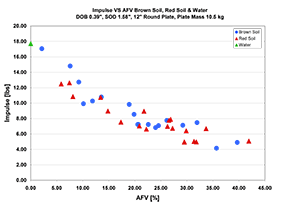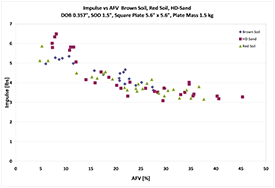![]() Investigation into Effects of Compaction and Water Content on Impulse Delivered to a Plate
Investigation into Effects of Compaction and Water Content on Impulse Delivered to a Plate
PI: William Fourney
We currently have three tasks underway: 1) Investigate effects of compaction and water content on Impulse delivered to a plate; 2) Effect of overburden and target standoff on target response; & 3) Detailed examination of loading mechanisms on target plates. We have made progress on all three but this report will concentrate on Task 1.
In previous work we had concentrated our efforts on examining the impulse applied to a target plate from sand and water. We used dry sand, saturated sand, and water and found for a plate that was big enough to catch all of the impulse that the impulse from saturated sand was twice that of dry sand and the impulse from water was about twice that of saturated sand. Our sponsor was interested in seeing the effect of water content and compaction was on the impulse delivered.
We have devised methods of carefully controlling both water content and compaction and have investigated an additional two soils in the study. We have also performed testing with two different target plate sizes – one large enough to catch all of the ejecta and one small in comparison to the size of the charge. The results of our studies to date are given in the two graphs (Figures 1 and 2).

Fig. 1: Impulse VS AFV Brown Soil, Red Soil and Water
Note that we are plotting impulse versus air filled voids (a combination of compaction and water content) and that although soil type (plotted on these graphs are water, a red soil, a brown soil, saturated sand, and dry sand) make some small difference, the largest effect is from the amount of air in the soil.

Fig. 2: Impulse VS AFV Brown Soil, Red Soil, HD-Sand
The first plot is for a large target plate while the second is for a small plate. These results are very promising from the standpoint of better understanding the loads applied to a vehicle subjected to the detonation of a buried charge.
The other two tasks are also well along and providing promising results.

